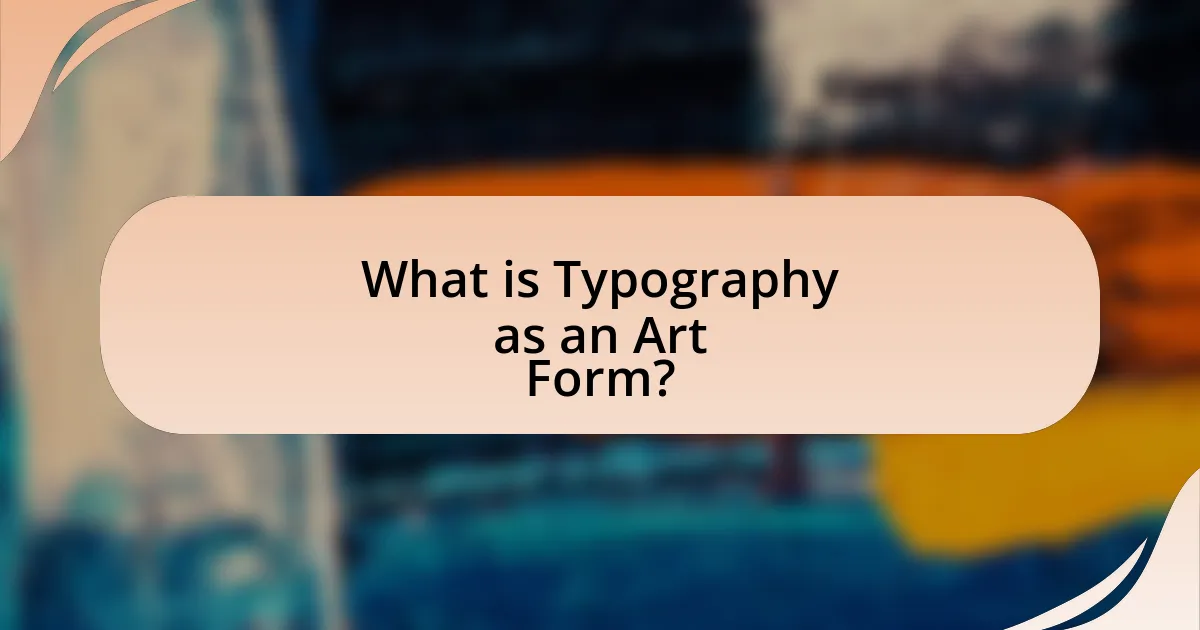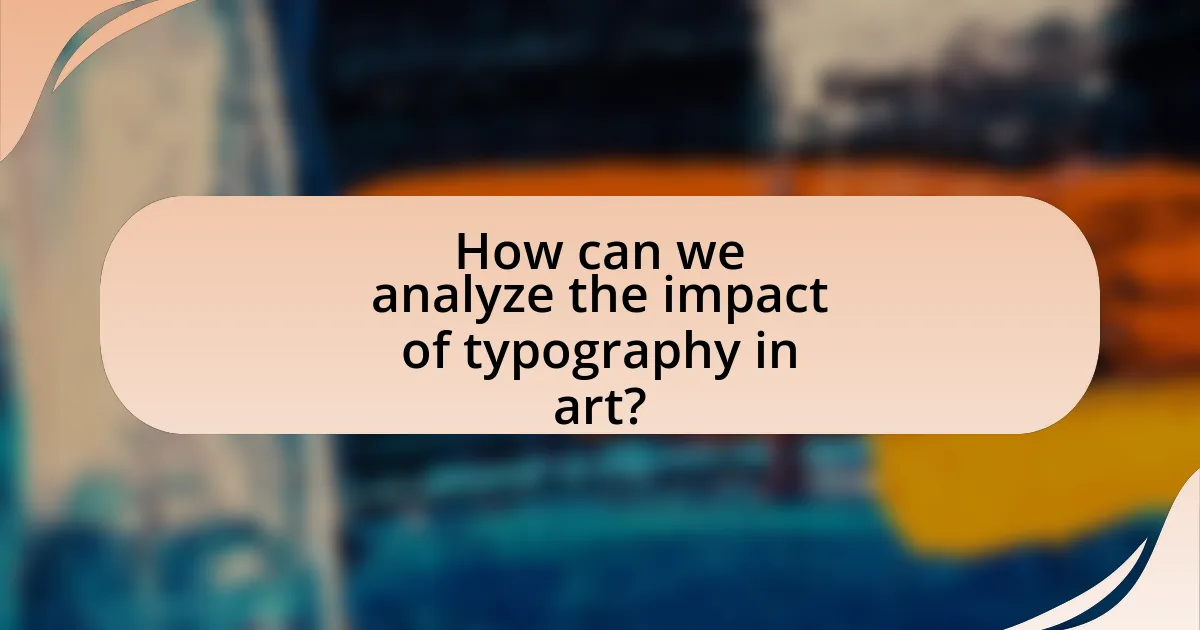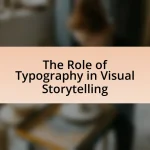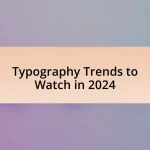Typography is defined as the visual arrangement of text that combines aesthetic appeal with effective communication. This article explores the evolution of typography as an art form, highlighting historical movements such as the Renaissance, Modernism, and Bauhaus, which have shaped its development. It examines the impact of cultural contexts on typographic styles, the significance of typography in visual communication, and its role in enhancing user experience in digital media. Additionally, the article discusses iconic typographic works, evaluates criteria for assessing typographic designs, and outlines best practices for contemporary designers, emphasizing the intersection of aesthetics and functionality in typography.

What is Typography as an Art Form?
Typography as an art form is the visual arrangement of text that emphasizes aesthetic appeal and communication effectiveness. This discipline combines elements such as typeface selection, spacing, and layout to create visually engaging designs that convey messages clearly. Historical examples, like the work of Jan Tschichold in the 20th century, demonstrate how typography can influence visual culture and enhance readability, showcasing its significance as both an artistic and functional medium.
How has typography evolved as a form of artistic expression?
Typography has evolved significantly as a form of artistic expression, transitioning from traditional typesetting to a diverse range of digital and experimental forms. Historically, typography began with movable type in the 15th century, pioneered by Johannes Gutenberg, which allowed for mass production of text and laid the foundation for modern graphic design. In the 20th century, movements such as Bauhaus and Swiss design emphasized clarity and functionality, influencing typographic aesthetics and leading to the development of sans-serif typefaces that are widely used today. The advent of digital technology in the late 20th century further transformed typography, enabling designers to manipulate type in innovative ways, such as through variable fonts and kinetic typography. This evolution reflects a broader cultural shift towards personalization and interactivity in design, allowing typography to serve not only as a means of communication but also as a medium for artistic expression.
What historical movements have influenced typography?
The historical movements that have influenced typography include the Renaissance, the Industrial Revolution, Modernism, and Postmodernism. The Renaissance marked a revival of classical learning and aesthetics, leading to the development of serif typefaces inspired by Roman inscriptions. The Industrial Revolution introduced mechanization, resulting in mass production of typefaces and the emergence of sans-serif styles for improved readability. Modernism emphasized simplicity and functionality, promoting clean lines and geometric forms in typography, as seen in the works of designers like Herbert Bayer. Postmodernism challenged established norms, incorporating eclectic styles and playful typography, reflecting cultural diversity and complexity. Each of these movements significantly shaped the evolution of typography, impacting design principles and practices throughout history.
How do cultural contexts shape typographic styles?
Cultural contexts significantly shape typographic styles by influencing design choices, symbolism, and readability. For instance, in Japan, the use of Kanji characters reflects cultural values of harmony and balance, leading to typographic designs that prioritize aesthetics and fluidity. In contrast, Western typography often emphasizes clarity and functionality, as seen in the use of sans-serif fonts for modern branding, which aligns with the cultural preference for minimalism and efficiency. Historical events, such as the Bauhaus movement in Germany, further illustrate how cultural shifts can lead to the adoption of geometric forms and experimental layouts, emphasizing the integration of art and technology. These examples demonstrate that typography is not merely a visual element but a reflection of the cultural narratives and values that inform its evolution.
Why is typography considered an essential element of design?
Typography is considered an essential element of design because it significantly influences readability, communication, and aesthetic appeal. Effective typography enhances the clarity of the message, ensuring that the intended information is conveyed accurately to the audience. Research indicates that well-chosen typefaces can improve comprehension by up to 30%, demonstrating the impact of typography on user experience. Additionally, typography contributes to the overall visual hierarchy, guiding the viewer’s attention and creating a cohesive design. This importance is evident in iconic works, where typography not only serves functional purposes but also embodies the artistic vision of the designer.
What role does typography play in visual communication?
Typography serves as a fundamental element in visual communication by conveying messages through the arrangement and style of text. It influences readability, establishes hierarchy, and evokes emotional responses, thereby enhancing the overall effectiveness of the communication. For instance, a study by the American Institute of Graphic Arts (AIGA) highlights that 95% of a message’s perception is influenced by typography, demonstrating its critical role in shaping audience interpretation and engagement.
How does typography affect user experience in digital media?
Typography significantly affects user experience in digital media by influencing readability, comprehension, and emotional response. Effective typography enhances clarity and guides users through content, making it easier for them to absorb information. Research indicates that well-chosen fonts can improve reading speed by up to 20% and increase retention rates, as seen in studies conducted by the University of Reading. Additionally, typography can evoke specific emotions; for instance, serif fonts often convey tradition and reliability, while sans-serif fonts are perceived as modern and clean. This emotional impact can shape user perceptions and engagement with digital content.
![]()
What are some iconic works in typography?
Some iconic works in typography include the Helvetica typeface, designed by Max Miedinger in 1957, which has become synonymous with modernist design and is widely used in branding and signage. Another significant work is the Bodoni typeface, created by Giambattista Bodoni in the late 18th century, known for its elegant and high-contrast letterforms that have influenced countless designs. Additionally, the typeface Garamond, originally designed by Claude Garamond in the 16th century, is celebrated for its readability and classic aesthetic, making it a staple in book publishing. These typefaces exemplify the evolution of typography and its impact on visual communication.
Which typographic works are recognized as milestones in the art form?
Milestones in the art of typography include works such as Johannes Gutenberg’s 42-line Bible, which marked the advent of movable type printing in the 15th century, revolutionizing the dissemination of information. Another significant work is the typeface Helvetica, designed by Max Miedinger in 1957, which became synonymous with modernist design and is widely used in various media. Additionally, the typeface Bodoni, created by Giambattista Bodoni in the late 18th century, is recognized for its contrast and elegance, influencing many subsequent type designs. These works are acknowledged for their profound impact on visual communication and design principles in typography.
What makes the Helvetica typeface iconic?
The Helvetica typeface is iconic due to its clean, modern design and versatility, which have made it a staple in graphic design and branding since its creation in 1957. Its neutrality allows it to be used in a wide range of applications, from corporate logos to public signage, making it universally recognizable. The typeface was developed by Swiss designer Max Miedinger and has been adopted by numerous global brands, including American Airlines and BMW, which further solidifies its status in the design community. Helvetica’s influence is evident in its extensive use in various media, contributing to its reputation as a symbol of modernist design principles.
How did the Bauhaus movement influence typographic design?
The Bauhaus movement significantly influenced typographic design by promoting functionalism and simplicity in visual communication. This approach led to the development of sans-serif typefaces, which emphasized clarity and legibility, aligning with the Bauhaus philosophy of merging art and technology. Notably, designers like Herbert Bayer created the Universal typeface, which eliminated unnecessary elements and showcased geometric forms, reflecting the movement’s emphasis on minimalism. The integration of typography with architecture and industrial design during this period established a cohesive visual language that prioritized practicality, influencing modern graphic design principles.
What contemporary examples showcase innovative typography?
Contemporary examples showcasing innovative typography include the work of designers like Jessica Walsh and Stefan Sagmeister, who utilize bold, experimental typefaces in their projects. For instance, Walsh’s collaboration with Sagmeister on the “Beauty” exhibition featured oversized, three-dimensional letters that engaged viewers in a tactile experience. Additionally, the digital type foundry, Typewolf, highlights innovative typefaces such as “Suisse Int’l” and “GT America,” which blend modern aesthetics with functional design. These examples illustrate how contemporary typography pushes boundaries through creativity and technology, reflecting current design trends and user engagement strategies.
How do modern designers push the boundaries of typography?
Modern designers push the boundaries of typography by experimenting with form, scale, and technology to create innovative visual experiences. They utilize variable fonts, which allow for a range of styles within a single typeface, enabling dynamic and responsive designs that adapt to different contexts. Additionally, designers incorporate 3D typography and kinetic type, which adds depth and movement, enhancing engagement. The integration of augmented reality (AR) and virtual reality (VR) further expands typographic possibilities, allowing for immersive experiences that challenge traditional reading formats. For instance, the use of generative design techniques enables the creation of unique typographic forms that evolve based on user interaction, exemplifying the intersection of art and technology in modern typography.
What role does technology play in contemporary typographic art?
Technology plays a crucial role in contemporary typographic art by enabling innovative design processes and enhancing creative expression. Digital tools such as graphic design software, 3D modeling applications, and web-based platforms allow artists to experiment with typography in ways that were previously impossible, facilitating the creation of dynamic and interactive text. For instance, the use of Adobe Illustrator and Photoshop has revolutionized how typographers manipulate letterforms, colors, and layouts, leading to more complex and visually engaging works. Additionally, advancements in printing technology, such as high-resolution digital printing and laser cutting, have expanded the possibilities for physical typographic installations, allowing for intricate designs that can be produced at scale. This integration of technology not only streamlines the design process but also fosters collaboration among artists, designers, and technologists, further pushing the boundaries of typographic art.

How can we analyze the impact of typography in art?
Analyzing the impact of typography in art involves examining how typeface choices influence visual communication and emotional response. Typography shapes the viewer’s perception by conveying tone, enhancing readability, and establishing a visual hierarchy. For instance, the use of bold sans-serif fonts in modern art can evoke a sense of strength and clarity, while ornate serif fonts may suggest tradition and elegance. Historical examples, such as the Bauhaus movement, illustrate how typography was integral to the overall aesthetic and message of artworks, emphasizing functionality and simplicity. Studies have shown that typography can significantly affect audience engagement, with research indicating that well-designed type can increase comprehension by up to 30%.
What criteria should be used to evaluate typographic works?
The criteria used to evaluate typographic works include legibility, aesthetics, functionality, and originality. Legibility assesses how easily text can be read, which is crucial for effective communication. Aesthetics evaluates the visual appeal and harmony of the typeface with the overall design, influencing the viewer’s emotional response. Functionality examines how well the typography serves its intended purpose, such as conveying information clearly in various contexts. Originality considers the uniqueness and creativity of the typographic design, which can set a work apart in a saturated market. These criteria are essential for determining the quality and impact of typographic works in the field of design.
How do aesthetics and functionality intersect in typography?
Aesthetics and functionality intersect in typography by ensuring that visual appeal enhances readability and communication effectiveness. Typography must balance artistic elements, such as font style and spacing, with practical considerations like legibility and accessibility. For instance, research by the International Journal of Design highlights that well-designed typefaces can improve reading speed and comprehension, demonstrating that aesthetic choices directly impact functionality. This intersection is crucial in creating designs that are not only visually striking but also serve their intended purpose effectively.
What are the emotional responses elicited by different typographic styles?
Different typographic styles elicit distinct emotional responses based on their design elements. For instance, serif fonts often convey tradition and reliability, evoking feelings of trust and stability, while sans-serif fonts tend to appear modern and clean, generating a sense of simplicity and clarity. Script fonts can evoke elegance and creativity, often associated with personal touch and warmth, whereas bold, heavy fonts may instill a sense of strength and urgency. Research by the International Journal of Design indicates that typography significantly influences perception and emotional engagement, demonstrating that the choice of typeface can alter the viewer’s emotional response to the content presented.
What lessons can be learned from studying iconic typographic works?
Studying iconic typographic works reveals essential lessons about design principles, cultural context, and the evolution of visual communication. These works demonstrate the importance of clarity and legibility, as seen in the Helvetica typeface, which has become a standard for modern design due to its clean lines and versatility. Additionally, iconic typographic pieces often reflect the cultural and historical context of their time, such as the use of bold, expressive type in protest posters, which conveys urgency and emotion. Furthermore, analyzing these works illustrates the impact of typography on branding and identity, exemplified by the Coca-Cola logo, which has maintained its distinctiveness and recognition over decades. Overall, these lessons emphasize the significance of thoughtful design choices in conveying messages effectively and resonating with audiences.
How can these lessons be applied to modern design practices?
The lessons from iconic typography can be applied to modern design practices by emphasizing the importance of clarity, hierarchy, and emotional resonance in visual communication. For instance, the use of contrasting typefaces to create visual interest and guide the viewer’s attention is a principle derived from historical typographic works, such as those by Paul Rand and Herb Lubalin. These designers demonstrated that effective typography not only conveys information but also evokes feelings, which is crucial in contemporary branding and advertising. Research indicates that well-designed typography can increase readability by up to 50%, enhancing user engagement and comprehension. Thus, integrating these lessons into modern design ensures that typography remains a powerful tool for effective communication.
What best practices should designers follow when creating typographic art?
Designers should prioritize clarity, hierarchy, and alignment when creating typographic art. Clarity ensures that the message is easily readable, which is essential for effective communication. Hierarchy guides the viewer’s eye through the design, emphasizing important elements through size, weight, and color variations. Alignment creates a cohesive look, enhancing the overall aesthetic and organization of the text. Research indicates that well-structured typography can significantly improve user engagement and comprehension, as seen in studies on visual communication effectiveness.

